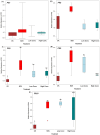Cyanobacterium Nostoc species mitigate soybean cyst nematode infection on soybean by shaping rhizosphere microbiota
- PMID: 40406346
- PMCID: PMC12097279
- DOI: 10.3389/fmicb.2025.1544479
Cyanobacterium Nostoc species mitigate soybean cyst nematode infection on soybean by shaping rhizosphere microbiota
Abstract
Soybean cyst nematode (SCN, Heterodera glycines Ichinohe) is the most devastating and yield-limiting pathogen that threatens soybean production globally. Sustainable SCN disease management strategies are needed. In this study, a cyanobacterial strain was isolated from SCN-infected soybean soil and identified as Nostoc punctiforme using the cyanobacterial 16S rRNA gene sequence. When susceptible soybean plants were grown in the SCN-inoculated soil, N. punctiforme inoculants significantly reduced the total number of SCN eggs and second-stage juveniles (J2s), compared to the control with SCN inoculation only. Further microbial analysis showed that N. punctiforme inoculants changed the bacterial and fungal communities in the soybean rhizospheres and significantly increased the relative abundance of several bacterial and fungal species with potential nematicidal activities, suggesting the changes of soybean rhizosphere microbiota may partially contribute to the activity of N. punctiforme inoculants against SCN. However, N. punctiforme inoculants did not directly induce soybean defense reactions against SCN. Thus, N. punctiforme may be a potential microbial source against SCN invasion in soybean.
Keywords: cyanobacteria; microbiota; nematicidal activity; plant defense system; soybean cyst nematode.
Copyright © 2025 Yin, Lahr and Zhou.
Conflict of interest statement
The authors declare that the research was conducted in the absence of any commercial or financial relationships that could be construed as a potential conflict of interest.
Figures






Similar articles
-
Redundancy in microbiota-mediated suppression of the soybean cyst nematode.Microbiome. 2024 Jul 15;12(1):125. doi: 10.1186/s40168-024-01840-x. Microbiome. 2024. PMID: 39004755 Free PMC article.
-
First Report of Soybean Cyst Nematode (Heterodera glycines Ichinohe) on Soybean in the Province of Quebec, Canada.Plant Dis. 2014 Mar;98(3):429. doi: 10.1094/PDIS-07-13-0782-PDN. Plant Dis. 2014. PMID: 30708422
-
Wheat Rhizosphere-Derived Bacteria Protect Soybean from Soilborne Diseases.Plant Dis. 2024 Jun;108(6):1565-1576. doi: 10.1094/PDIS-08-23-1713-RE. Epub 2024 May 30. Plant Dis. 2024. PMID: 38105448
-
Successive soybean-monoculture cropping assembles rhizosphere microbial communities for the soil suppression of soybean cyst nematode.FEMS Microbiol Ecol. 2017 Jan 1;93(1). doi: 10.1093/femsec/fiw222. FEMS Microbiol Ecol. 2017. PMID: 27789537
-
Soybean cyst nematode detection and management: a review.Plant Methods. 2022 Sep 7;18(1):110. doi: 10.1186/s13007-022-00933-8. Plant Methods. 2022. PMID: 36071455 Free PMC article. Review.
References
-
- Allen T. W., Bradley C. A., Sisson A. J., Byamukama E., Chilvers M. I., Coker C. M., et al. . (2017). Soybean yield loss estimates due to diseases in the United States and Ontario, Canada, from 2010 to 2014. Plant Health Prog. 18, 19–27. 10.1094/PHP-RS-16-0066 - DOI
-
- Alvarez A. L., Weyers S. L., Gardner R. D. (2024). Cyanobacteria-based soil amendments in the soil-plant system: effects of inoculations on soil nutrient and microbial dynamics under spring wheat growth. Algal Res. 77:103326. 10.1016/j.algal.2023.103326 - DOI
-
- Alves L. C., De Souza J. A. M., de Mello Varani A., de Macedo Lemos E. G. (2014). “The Family Rhizobiaceae,” in The Prokaryotes eds. Rosenberg E., DeLong E. F., Lory S., et al.. (Berlin, Heidelberg: Springer; ), 419–437. 10.1007/978-3-642-30197-1_297 - DOI
LinkOut - more resources
Full Text Sources

